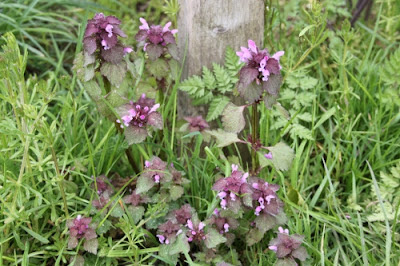The strip of land alongside our mooring has to be the best garden I've ever had. When we first saw it, thistles and nettles dominated, but since they were chopped down last year, all sorts of other plants have emerged - and the thistles and nettles are making a comeback too.
I went out yesterday and photographed all the different species I could find - when I added up the photos, I was amazed to discover that I had found forty different plants. Plus I am sure there are a lot more I have missed.
The trouble is, I have no idea what most of them are. The stage of life where you learn to identify plants and trees and birds and insects seems to have passed me by completely. So I am going to ask you, dear readers, to tell me what they are - I know there are at least one or two people out there who will be able to do just that. To make it easier, I'll number them; and to keep it manageable I will restrict this post to the ones that are currently in flower.
First of all, the ones I'm pretty sure I do know:
1. Forget-me-not. Truly wild, or a garden escapee?
2. Dandelion. There, I said I knew some of them!
3. Pretty sure this is a white dead nettle...
Now the ones I'm not so sure about:
4. Is this Queen Anne's Lace?
5. Some kind of nettle, but does this one with purple flowers have a special name? I think there is a second variety of stinging nettle here too which isn't in flower - a bit bigger. Does that sound likely?
Finally, the largest group - those I have no idea about. Over to you!
6.
7.
8.
9.
Thank you!
Sutton Park and The Royal
23 hours ago










No 9 looks like ribwort plantain, and 7 red dead nettle. Possibly.
ReplyDelete4 could turn out to be yarrow when it grows up.
ReplyDeleteThere are loads of nettle varieties. At Wicken fen we saw some big nettles that looked just like stingers but they didn't sting.
I think 7 is purple archangel, just as the white deadnettle (3) is white archangel. Did you know if you pick the white deadnettle flower and suck the pointed end you sometimes get a tiny taste of the incredibly sweet nectar. very nice. Sometimes you have to try a few before you get it.
1. is forget-me-not--which is the Alaska State Flower.
ReplyDelete2. Dandelion is a very stong healing plant. The root is very good for liver, kidneys, pancreas, gall bladder, intestines, and blood--essentially one's immune system organs.
3. Dead nettle--called such since it does not sting.
4. Look's to me like poison Hemlock. Queen Anne's Lace has a wide umble of white flowers like a ladies dress turned upside down. Poision hemlock has white flowers in umbels too, but they are in small clusters like your picture.
5. Stinging nettle. Thre are 500 species of nettles which grow across the world. Not sure which specific species this one is, but it does sting--and it is edible and a very healthful herb. I pick the first four leaves at the top, with gloves on, then blanche them for five minutes in a sink full of boiling water. It takes away the sting. they are delicious layerd in lasagn and mixed into scrambled eggs. I also dry them and crumble them up and keep the leaf bits in a jar. I add them to soups the last 20 minutes before serving. It is a nutrative herb taht gently cleanses the body of toxic wastes.
6. I have no idea!
7. Red Dead nettle of yes, Purple Archangel is also a name for it.
8. I have no idea!
9. Ribwort Plantain makes an effective treatment for wound bleeding. It contains epidermal growth factor, stimulating the repair of damaged tissue. the leaves have antibacterial properties. Plantain can be used in an asortment of treatments: diarrhea, gastritis, hemorrhage, hemorrhoids, in cases of irritable bowel, against bronchitis, catarrh, sinusitis and asthma. Externally, a decoction obtained from the leaves is used in cases of skin inflammations, cuts, stings and malignant ulcers. Plantain root is useful in cases of rattlesnake bite. Seeds, having a high mucilage content, are a good remedy against parasitic worms. Distilled water made from the plant makes an excellent eye lotion. Tea made from the seed is helpful in treatment of diarrhea, dysentery and bleedings of mucous membranes. The seeds are a component of those commerical powders added to water to provide dietary fiber and mucilage for a healthy gut.
Wow, thanks Jaq - I knew you'd have some answers for me!
ReplyDeleteI think no.8 is sweet woodruff. A really nice perrenial ground cover plant in partial shade.
ReplyDelete